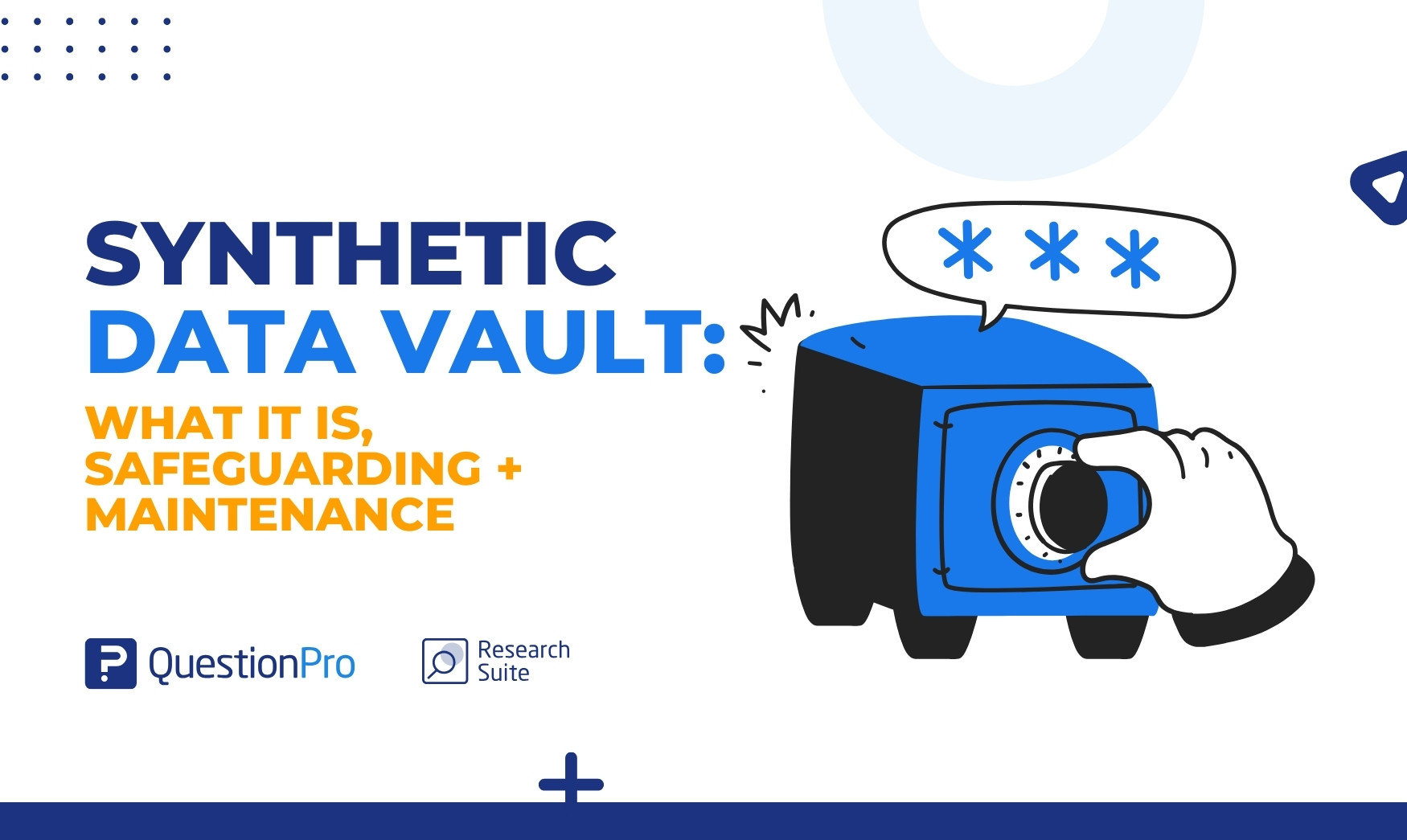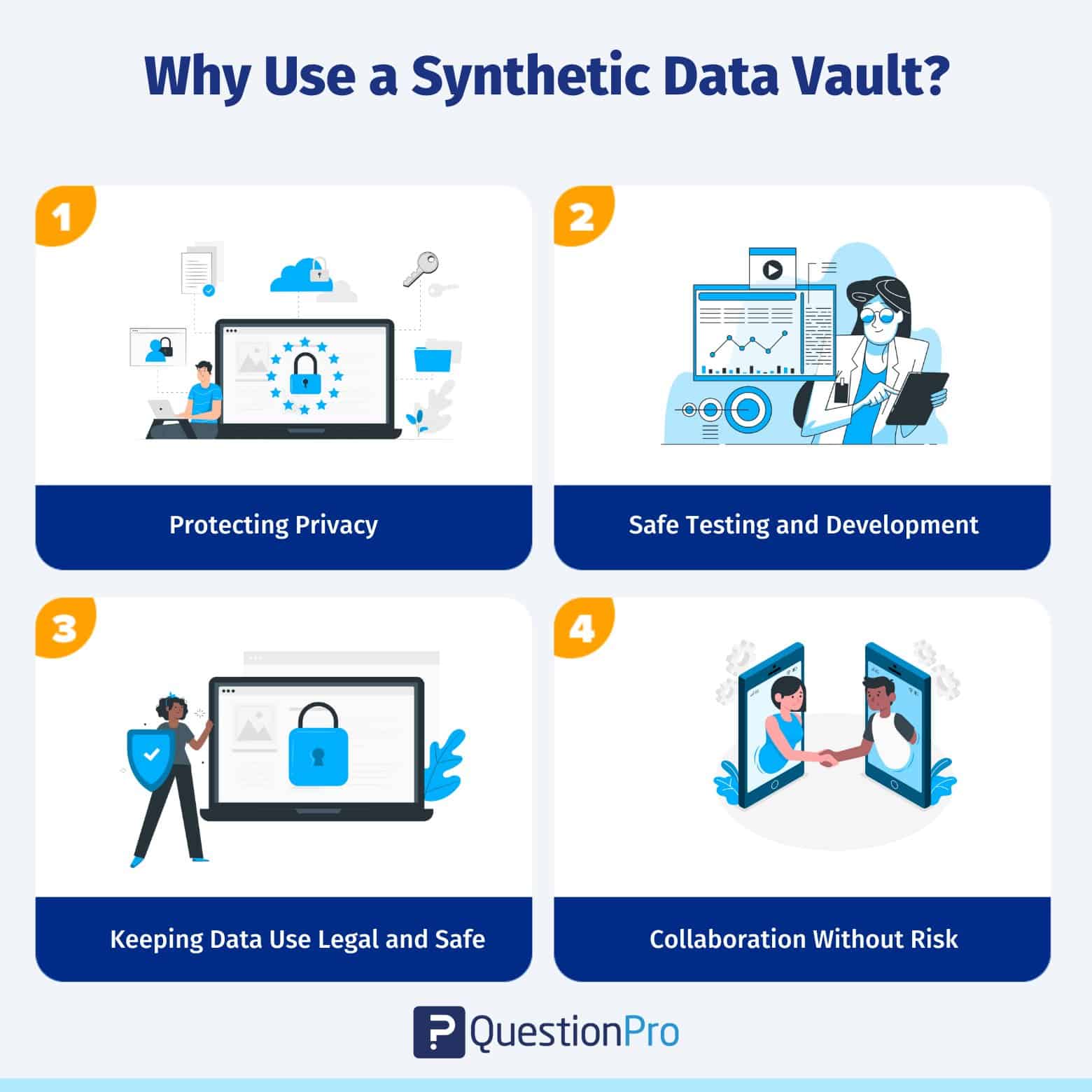
Ensuring the security of private information while using data is crucial in data science. With a synthetic data vault, you can protect data privacy without compromising usability. This safe storage box acts as a stronghold for businesses using synthetic data to protect sensitive data from outsiders.
In this blog, we’ll learn about synthetic data vaults, exploring what they are, their role in data privacy, and the critical aspects of management and security.
What is a Synthetic Data Vault?
A Synthetic Data Vault (SDV) is similar to a data library. It’s a storage where you can work with different kinds of datasets, like single tables, multiple tables, or data that changes over time, known as time series data. It can generate data that appears and behaves just like your original data.
This synthetic data can be really beneficial. For example, you can use it to train machine learning models without worrying about using real, sensitive data. It’s also useful for testing data-driven software like machine learning systems without risking data leaks.
SDV uses smart techniques to generate synthetic data, like probabilistic graphical modeling and deep learning. It also employs synthetic data generation models, such as generative modeling and recurrent sampling, while working with various data structures. Using SDV, you can compare the generated artificial data to the real data for evaluating synthetic data.
Why Use a Synthetic Data Vault?
If you’re wondering why anyone would bother using synthetic data, here are a few solid reasons:

1. Protecting Privacy
This is the big one. Synthetic data helps protect people’s personal information. Since the data is fake, you don’t need to worry about exposing real identities.
2. Safe Testing and Development
Need to test your app, software, or AI system? With synthetic data, developers can build and test products without needing access to real customer data.
3. Keeping Data Use Legal and Safe
Industries like healthcare, finance, and insurance have strict privacy laws (like GDPR or HIPAA). Using a Synthetic Data Vault helps you stay compliant by avoiding the use of real PII (personally identifiable information).
4. Collaboration Without Risk
Want to share data with partners or research teams? You can use synthetic data that’s safe to share without breaching any rules.
Synthetic Data Vault Components
Synthetic data vaults use several critical components to create synthetic data. It also stores and manages synthetic data while protecting data privacy and security. These components may vary by implementation, but SDV typically has these:
- Data Generator: Data generation is a primary key functionality of a synthetic data vault that replicates real data’s statistical qualities and attributes. This involves the creation of single-table data, multi-table data, and time series data.
- Data Repository: The data repository stores both actual and generated data. It offers a safe and well-organized storage environment for data access and retrieval when needed.
- Data Privacy and Security Layer: This crucial layer protects fake data and ensures data privacy and security. It contains encryption techniques, access controls, user authentication, and data masking or anonymization features to safeguard sensitive information.
- Data Quality Control Tools: The synthetic data vault consists of tools and methods for data validation, cleansing, and transformation to verify that the generated synthetic data fulfills quality criteria. This contributes to data accuracy and consistency.
- Data Customization Interface: Users frequently require the flexibility to modify the synthetic data production process. This feature provides a user interface through which users can create data types, table relationships, and other settings based on their individual needs.
- Data Refreshing method: As real data changes over time, the Synthetic Data Vault provides a refreshing method to reflect these changes in the synthetic data. This guarantees that the synthetic data remains updated and relevant.
- Data Export and Integration Interfaces: Users can export synthetic data from the vault for various purposes, such as training machine learning models or testing software. Integration interfaces allow a smooth connection with different data analysis and machine learning tools.
If you want to learn more, read this blog: 11 Best Synthetic Data Generation Tools in 2024
Safeguarding Data Privacy
Working with synthetic data gives you access to a powerful solution for protecting data privacy, especially when dealing with sensitive or personally identifiable information (PII). Your synthetic data is secure within the Synthetic Data Vault.
This vault employs encryption, access controls, and data masking to ensure that no one without appropriate authorization may gain access to it. This ensures your simulated data remains private and safe from potential security concerns.
The goal of creating synthetic data is to prioritize privacy from the outset. It follows a “privacy by design” philosophy, which implies that it has been carefully developed to ensure that no genuine, sensitive information is ever exposed or used in any way. It also greatly decreases the possibility of data breaches or privacy violations, which provides you with peace of mind when working with data.
Managing and Maintaining Synthetic Data
Managing and maintaining synthetic data within a synthetic data vault is necessary to ensure its ongoing quality, privacy, and usefulness. You can use several essential management techniques for success, such as:
- Regular Data Refreshing: You should refresh synthetic data regularly to ensure that it appropriately reflects changes in real data.
- Data Validation and Quality Assurance: Monitor data quality and accuracy continuously. You can use automated tests to identify any anomalies or discrepancies.
- Version Control: Track changes and updates to synthetic data to ensure data continuity and create a history of changes.
- Data Privacy Protection: Regularly evaluate the efficiency of privacy security measures, such as data masking and anonymization.
- Security Updates: Keep the Synthetic Data Vault’s software and infrastructure components updated with security patches to ensure overall system security.
- Access Control and User Reviews: Review user access rights and permissions regularly to prevent unwanted access and preserve data security.
- User Training and Support: Provide ongoing resources for user training and assistance with any issues or questions that may occur during synthetic data usage.
Conclusion
The synthetic data vault functions similarly to a high-tech safe for your data. It enables businesses to keep sensitive information secure and confidential while using it for research and analysis. It manages this by generating fake data that appears and behaves like genuine stuff but contains no sensitive information. This way, you can work with the data without concern about privacy or security.
It’s especially useful in healthcare, banking, and research industries, where data is crucial but must be treated carefully. The Synthetic Data Vault allows you to be creative and work with others without violating any privacy or security regulations.
QuestionPro Research Suite is an excellent survey platform for data collection and research needs. It allows you to collect, analyze, and manage survey data, which can be input for synthetic data generators.
QuestionPro can streamline data collection. However, synthetic data generation usually requires extra tools, libraries, or platforms that specialize in generating synthetic data.
You can sign up for a free trial to learn how QuestionPro can help you with your data collection and research needs. It offers advanced features for creating surveys, distributing them, and collecting data, which can be really useful for your projects.
Frequently Asked Questions (FAQs)
Answer: Using a synthetic data vault helps protect privacy, reduce compliance risks, and safely test or train machine learning models. It replicates statistical properties of real data without exposing actual user or customer information.
Answer: Synthetic data is created using advanced methods like probabilistic modeling, deep learning, and generative models. These methods replicate the patterns and distributions of real data across single tables, multiple tables, or time series datasets.
Answer: It uses built-in privacy-by-design principles, including encryption, access control, anonymization, and masking to ensure that synthetic data never exposes real sensitive information.
Answer: Synthetic data can often substitute for real data in machine learning training and testing, especially when privacy is a concern. However, its effectiveness depends on the quality and realism of the synthetic data generated.
Answer: A data generator focuses only on creating synthetic data. A synthetic data vault includes generation plus secure storage, privacy protection, data quality control, export tools, and long-term data maintenance features.







